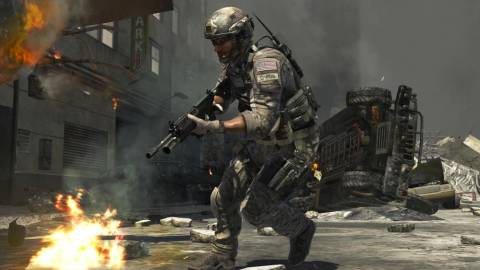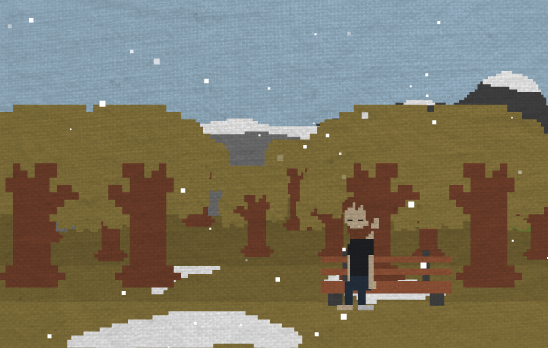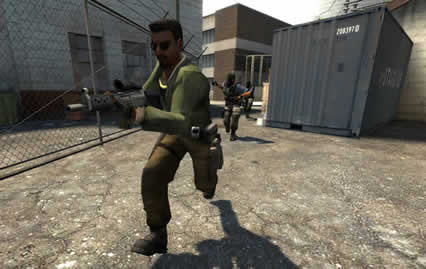The Permanence of Death and the Military Fantasy in Games
By nkornek 16 Comments
The Permanence of Death and the Military Fantasy in Games
War, violence, and death are some of the subjects most frequently tackled by video games. The reason behind this stems from the much larger question of why people play video games at all. According to many gaming-centric forums and websites, games can provide a form of escapism, a power fantasy, or even a way of relieving anger and stress. Additionally, first-person shooter games in particular are seen as one of the more accessible genres because of their frequent use of pre-established gaming conventions such as controls . The attraction to these types of games may be psychological as well, as described by Yahoo Answers member Ziegenkonig.
“People crave new and exciting experiences in life. Most of the new experiences, such as the thrill of a battle or war, are rather dangerous. So, people turn to the next best thing, which would be [first-person-shooters]. [Shooters] provide people with a turn from the normal everyday boring routines of life, to a more fast-paced, adventurous lifestyle. It lets everybody do what seems impossible, which is fighting in a violent battle without risk of actually losing your life” .

The vision of carrying out brutal conflicts without bloodshed is not confined to the imaginary worlds portrayed in games. It serves as a driving force behind the development of military technology such as remote-operated drones, and is described by Ashley Dawson and Stephen Graham as the “military fantasy” . The notion of a war without death is already so deeply ingrained in the minds of players that the expectation of “re-spawning” in games feels as normal as Althusser’s descriptions of the unconscious acts of greeting that are societal norms . Very few games are able to break through these conventions, especially regarding player death, despite the fact that in reality death is permanent. Embracing the permanence of death can be used to great emotional effect in smaller art games such as One Chance, but the notion may not be viable for larger commercial products. This is why most prominent first-person shooter games, particularly multiplayer focused ones such as Battlefield 3 and Counter-Strike Source, interpolate players with this military fantasy of a war without the risk of death, and make it possible to experience victories that could never be. Electronic Arts and DICE’s Battlefield series aims to do so by negating the significance of death almost entirely through its advanced uses of “re-spawning” while Valve’s Counter Strike Source actually gives players a taste of the consequences of their actions before allowing them to return to the game.
As military technology advances, its developers dream of approximating the deathless conflicts that are currently only possible in fictional worlds such as those of video games. Dawson defines the modern ideal of the military fantasy as “the desire to avoid eroding domestic consent through the high death toll of city-based combat” . Urban combat is regarded by many soldiers as the bloodiest and most difficult of combat scenarios . In order to reduce casualties armies seek to develop their technology to the point that they are able to remove living soldiers from the battlefield entirely. While robotic foot soldiers are presently confined to the realm of science fiction, developers of military technologies such as the Defense Advanced Research Projects Agency (DARPA) have manufactured and deployed both fully-automated as well as human controlled drones with a variety of potential applications. The eventual goal is to “help save lives by taking humans out of harm’s way” . The military fantasy is a war fought by proxies, a war with little to no casualties, at least on the winning side. Advancements in game development are also being applied to advance the development of military technology. Johnson describes how the United States Armed Forces have been working with Crytek’s CryEngine 3 to develop a hyper-realistic simulator to train their soldiers for real-world combat scenarios . While the final product will never be something that the average consumer would be able to play, it is still built on a platform that was intended for the creation of mass-market products. As the lines between games, simulations, and reality become blurred we begin to approach the same ideals behind the fictional Battle School from Orson Scott Card’s novel Ender’s Game . While it may be pure conjecture, it is not impossible to imagine a future where soldiers can control combat drones in a manner similar to the way players control their avatars in first-person shooters.
The lack of permanent death in video games has become something so conventional that most gamers would view anything different as being unplayable. Althusser describes how ideological interpolation works by appealing to the subject’s pre-existing notions of what is normal . By playing to these notions, one can garner a greater feeling of association from the target audience. Video games frequently follow these established conventions as a way of appealing to a larger player base, but certain games such as Awkward Silence’s One Chance are able to embrace the confines of death’s permanence. The game was created for the sole purpose of exploring the idea of permanency. As the title suggests, the player is only ever given one chance to complete the story since, upon ending, the game saves a file to the player’s computer that actually prevents them from being able to start over. The game deals with the notion of impending and unavoidable death, and gives the player the choices of how they wish to spend their final days. After each day the game declares “In [X] days every single living cell on planet earth will be dead, you have one chance” . What is never explicitly stated by the game is what the “chance” is for. The player is thus given the option of whether to desperately work to attempt to cure the virus that will eradicate all life or spend their final days with their loving family, with them never being able to know what may have happened had they chosen differently. In addition, the game never actually tells the player that they will be unable to re-play it, and only makes it apparent when one attempts to do so. It plays to the dominant ideology that games can be repeated even after player death. The notion of not being able to return to the game after death may seem novel when it comes to video games, but it is actually a reflection of reality. Everyone knows that as humans we cannot return after death, yet all players expect to have multiple lives in videogames. What’s more is that players are keenly aware of the difference, as remarked by Yahoo Answers member Osito “Better yet, join war if u want to. See how many respawns you get” [sic] . People acknowledge that the lack of death in games represents an unattainable fantasy. The opposing assumptions that players make about how death functions in reality and in video games act as a terrific example of Althusser’s notion that, whether they realize it or not, everyone is always the subject of ideology . While it may be possible for smaller games like One Chance to highlight the importance of death’s permanence, such an idea would not be feasible in the expensive consumer focused products such as Battlefield 3.

EA Game’s blockbuster first-person shooter Battlefield 3 chooses to eschew the reality of death’s permanence in favor of a representation of the military fantasy of a war without death. It accomplishes this primarily through its multiplayer mode, which allows up to 64 players to wage large-scale battles in teams of 32 players each. While it is entirely possible for the player’s avatar to die in such conflicts, the game is built to minimize the consequence of death, allowing them to re-spawn into the game, usually within less than ten seconds of their demise. Death is not only inconsequential in the game, but it is actually entirely common. In the average fifty-minute game of Battlefield 3’s conquest mode, the total number of player deaths can often reach four or five hundred deaths per team. As a comparison, consider that the total death toll of American troops in Afghanistan for the entire year of 2010 was approximately four hundred . The result is that the player views their in-game avatar as just that, a blank slate for them to operate and then discard before beginning anew in another body. Battlefield 3’s re-spawn mechanic so wholly embodies the military fantasy that it can even allow death to be used as an advantage; dead players are temporarily given a significantly larger tactical view of the battlefield as well as the ability to spawn in a location of their choosing to ensure that soldiers can immediately be where they need to be. Using death as a strategic advantage is so embedded into the game’s mentality that the developers actually included a Suicide button that allows the player to kill themselves if they were ever to be in a less favorable position. Being able to view the entire battlefield and dispense soldiers to the exact locations where they are needed is exactly the type of fantasy technology that Graham describes as DARPA’s “Combat Zones That See” project which seeks to apply similar mechanics to real-world battlefields, albeit without the suicides .

Valve’s Counter Strike Source may employ techniques that give dead players a tactical advantage similar to those present in Battlefield 3, but it differs in the fact that death actually carries with it larger consequences. While the game does still offer players the ability to re-spawn after death, it restricts the option to only allow them to return after the completion of a full round. The result is a more realistic representation of death’s consequences; a dead player means one less soldier on the battlefield to help his brothers in their mission, which leads to players making a greater effort to protect their comrades and to remain alive themselves, just like in real combat. Counter Strike also allows players to experience another aspect of the military fantasy: counter-narratives of victories that have never taken place. The game itself is a depiction of the war on terror, featuring teams of elite soldiers from several of the world’s benevolent military powers confronting terrorists. The counter-narrative arises from player’s ability to play as the team of terrorists, whose goal is frequently to detonate a bomb and cause destruction. It thus allows players to enjoy committing acts of terror that they would ordinarily condemn, and frequently the game will end with the announcement of “terrorists win”. This is not dissimilar to what Penney describes as the revisionist war narrative in Japan. There, several forms of fictional media depict the events of the Second World War as ending with Japan’s armies victorious . Just like these counter-narratives, Counter Strike allows players to rewrite their notions of the war on terror to turn their enemy’s victories into something positive.
The military fantasy of war without death may still be far from becoming a reality, but it is alive and well in video games such as Battlefield 3 and Counter Strike Source. Most players are already interpolated with the opposing notions of death in games and reality, and smaller art games such as One Chance are able to expose that ideology by reversing the convention. Larger games such as Battlefield 3 instead choose instead to embrace the ideology of death’s impermanence in games and fully depict the military fantasy through their use of death as a tactical advantage. Other games like Counter Strike Source still acknowledge this convention, but still realistically depict the consequences of a soldier’s death in a combat scenario. The fictionalization of these conflicts also allows players to rewrite reality and view the virtual victories of their nation’s enemies as something positive. As the line between military technology and video games becomes increasingly blurred, the military fantasy that games depict inches ever closer to reality.
